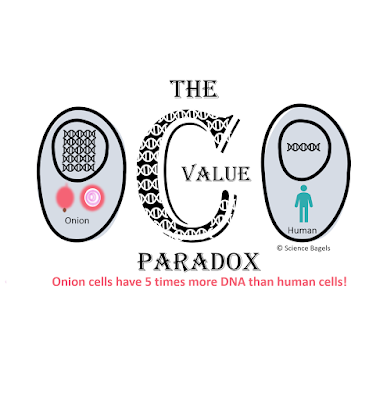DNA is the code that is responsible for storing the information of life. Genes are functional units present in DNA that makes up proteins. It thus can be thought that the more complex an organism, the more number of proteins it would be making and so more the number of genes present in its DNA. The size of DNA does vary amongst different species, but a simple correlation with respect to complexity of an organism and the size of its DNA does not hold true. This brings us to one of the long standing paradoxes of Biology, the C value paradox.
What is C value? C value represents the amount of DNA present inside a single cell. Multicellular organisms have multiple copies of DNA inside their cell, being diploid (2 copies), tetraploid (4 copies) and so on. C value refers to the size of DNA present in a single copy of DNA inside a cell.
What is C value? C value represents the amount of DNA present inside a single cell. Multicellular organisms have multiple copies of DNA inside their cell, being diploid (2 copies), tetraploid (4 copies) and so on. C value refers to the size of DNA present in a single copy of DNA inside a cell.
What is the C value paradox? The complexity of an organism and the C value do not correlate. Less complex organisms have much more DNA than more complex organisms. An example is the onion that has 5 times more DNA inside its cells than present inside a human cell.
How can we explain the C value paradox? Although the C value paradox has not still been resolved, but there have been certain revelations that can help us in solving this mystery.
1. Not all of the DNA codes for genes.
It was found that only 15-20% of human genome codes for proteins. The remaining 80% is composed of what is called as junk DNA, which does not produce proteins.
2. Junk DNA is not really trash.
There are multiple jumping genes called as transposons present in the junk DNA, which can serve as designers of mutations and lead to diversity that arises amongst different organisms of a species. These transposons can move from one site in the DNA to another, termed as jumps and if they happen to land up in a gene then they change the sequence of that gene. The sole purpose of these jumping genes is to replicate and survive, irrespective of their host DNA and the need of the host.
3. The code is encoded.
The junk DNA also contains elements that can control expression of genes, acting as switches that can switch on and off genes. These include what is called as epigenetic factors and provide an encoding for the expression of genetic code. Recent attempts have found that 80% of the DNA is composed of such functional units.
Still all these above facts do not explain or resolve the C value paradox, but what can be drawn from this information is the following:
1. The presence of functional units in DNA points out towards the gap in our understanding between genes and how they are expressed. It is thus required to probe for similar units in other species' genomes.
2. The study of evolutionary processes that created the encryption that is provided by epigenetic factors would provide insights into how these evolved and is possible might also resolve the C value paradox.
3. There could be a function of the remaining junk DNA besides jumping genes and functional elements that we still have not figured out yet. One such possible role is in creating structural support to the DNA.
Thus, there is more to DNA than just genes and it is still a mystery that is awaiting to be solved in times to come!
References:

Comments
Post a Comment